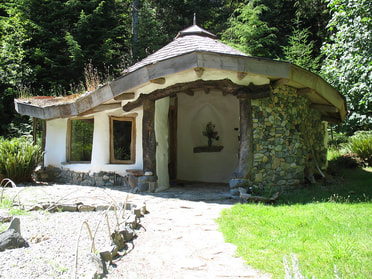A Quick Explanation of Cob Building

What is cob?
Cob is another take on the classic building material that is the earth around us. You may be familiar with adobe and rammed earth methods and cob shares many of the same attributes with those methods. Cob is made up of a mixture of clay, sand, straw, water and sometimes manure for added strength. Unlike adobe cob is not pressed in brick forms to dry nor is it compacted into forms like rammed earth. How is it used to build? Cob is one perhaps one the least understand methods of earthen building and that is partly because one of the main epicenters of cob building was in England. During the late 1800’s with the advent of the fired brick in England, cob building went by the wayside as brick was easier to build with on a mass scale. Cob is assembled in a method called lifts, where a layer of cob is placed on top of the foundation wall or the previous layer of cob. This lift is then left to dry and harden while more cob is being mixed up. The previous work has to be allowed to drive otherwise it will deform when the weight of the new layer of cob is placed on. How does it hold up? There is a saying that has been associated with cob building “ All cob wants is a good hat and a good pair of shoes.” I am paraphrasing a bit there but the basic point is with a solid raised foundation and roof with good sized overhangs a cob house when built right will last centuries. I not just saying that, there are cob houses in England that have been inhabited for centuries and have undergone the various housing upgrades like plumbing and electricity. Further Reading For further information on cob building I would recommend the following two books Building with Cob by Adam Weismann & Katy Bryce The Hand Sculpted House by Ianto Evans, Michael G. Smith, Linda Smiley, Deanne Bednar Sources: http://www.networkearth.org/naturalbuilding/history.html http://www.devonearthbuilding.com/leaflets/cob_buildings_of_devon_1.pdf |
Further Reading |
“As an Amazon Associate I earn from qualifying purchases.”

